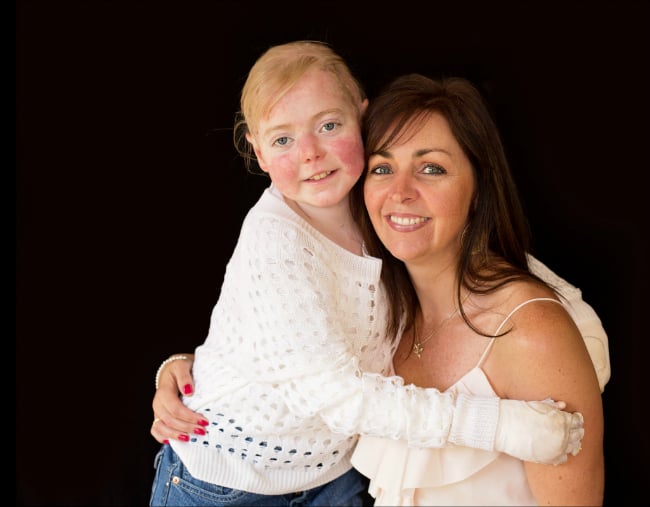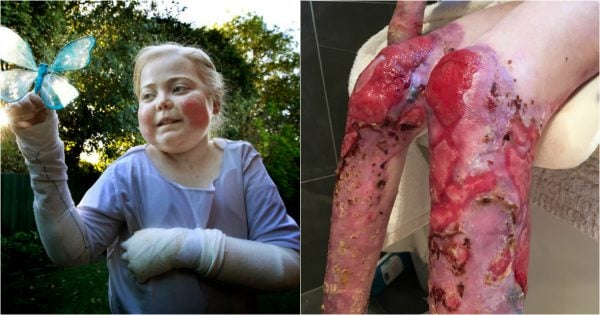I was introduced to the world of EB in 2000 when my daughter Eliza was born with Recessive Dystrophic Epidermolysis Bullosa (RDEB).
My husband and I started the journey of being first time parents in a state of sadness, desperation, frustration and a sense of being constantly overwhelmed. In the years to come we welcomed our second child into the family, and along with the support of DEBRA Australia, family and friends, and support services we have lead a very fulfilling but restricted life which tragically came crashing down around us two weeks before Christmas last year, on December 12, 2017.
EB takes the utmost love, dedication and determination (and a sense of humour doesn’t go astray) just to name a few attributes to deal with new challenges that EB presents on a daily basis.
Everyone meets challenges in life – some things we have little or no control over – but it is how you deal with the challenges that counts. When living with EB, it’s important to make each day count!
Imagine being given a gift… A gift of life, you are so excited to become a first time mother and all you can wish for is that your child arrives safely and as that time gets closer you can’t wait to hold them.
Who would have thought a mother’s touch would cause their baby pain? This was the reality I was hit with when our beautiful baby Eliza arrived on January 28, 2000. As soon as I held her in my arms it was very apparent that there was something wrong. She was born with large raw areas extending over her feet, right leg & knee, her hands and her mouth. She was born at a local private hospital and was immediately transferred to the Royal Children’s Hospital and after a terrifying and long 2 weeks, she was diagnosed RDEB. I still remember the empty feeling that took over my whole body.
Eliza was going to be affected from a debilitating medical condition that became worse with life. It was one of the more severe types of EB and referred to as ‘the worst disease you’ve never heard of’.

Doctors advised Eliza would be in constant pain, she required morning & evening dressing changes including salt & bleach baths which took approximately three hours, three times a week. Her fingers and toes would web and form strictures, the skin in her throat would become so tight from scar tissue that she wouldn’t be able to eat normal food, or at desperate times even be able to swallow her own saliva. Eliza would suffer from corneal abrasions which means her eyes would be closed for 3-5 days at a time, in a darkened room due to a tear on her cornea. Her mobility would be affected, she would require bandages and dressings all over her body every day of her life and she wouldn’t be able to wear normal clothes or undergarments because even the seams on the inside of the clothes would blister her skin. It was going to change our lives forever and it did.
Eliza screamed for her first 6 months, she failed to thrive due to blisters in her mouth and throat, she required various medications, up to 24 each day, and she required help throughout the night. She totally turned our lives upside down.
Severe EB requires many hospitalisations for various related complications. Eliza had over 100 general anesthetics and day admissions, and 60 admissions requiring lengthy stays.
One of many reflections of living with severe EB was on Eliza’s 15th Birthday, when she woke with a corneal abrasion. She was crying in pain, eyes were swollen & tearing, she couldn’t open them.
See Also: What Are the Biggest Reasons Diets Fail?
After she had some pain relief she settled down & sat in bed feeling her wrapped birthday presents, trying to guess what they were?
I watched & thought to myself how could life be so cruel? EB had taken away her independence, her mobility, she couldn’t eat or enjoy her birthday cake & if that’s wasn’t bad enough, it also took away the joy of opening her presents.
EB is ruthless, unforgiving, it has no boundaries and it’s sad to see how it robs individuals, especially children of a fair go in life.
It was times like this that we were so thankful for our family & friends but especially thankful for the support DEBRA Australia offered. To have the support of an organisation who are with you 100% of the way, and pick up the pieces for families who fall through the cracks of the health system is an enormous comfort in itself. DEBRA is a small community that connects you to likeminded families who are going through the same journey.
Eliza was not your average adolescent in more ways than one. She was truly in a league of her own. The depth of her pain and suffering was surpassed only by her polite and gentle charm, attention to data and detail, thorough knowledge of her own medical history, humility, a cheeky smile and sharp wit, and her sheer grit and determination in everything she set her mind to. Eliza didn't see her EB as a burden - it was part of her, but did not define her.
On 17th August 2017, Eliza became unwell and was admitted to the Royal Children’s hospital with what was first diagnosed as a chest infection. Soon after it became obvious that Eliza had kidney impairment and over the next four months she spent majority of her life in hospital for renal treatment which consisted of being hooked up for many infusions lasting up to 10 hours each day. Eliza continued to deteriorate and sadly passed away on 12thDecember 2017, just 6 weeks short of her 18th birthday. We lay with her as she took her final breath and wished she didn’t have to suffer from this hideous disease.
Source: https://www.mamamia.com.au

































